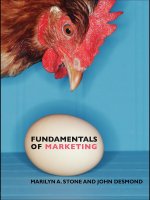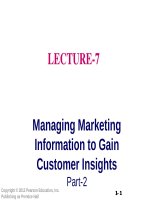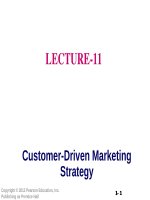Lecture fundamentals of marketing - Lecture 9: Consumer markets and consumer buyer behavior (Part 2)
Bạn đang xem bản rút gọn của tài liệu. Xem và tải ngay bản đầy đủ của tài liệu tại đây (689.76 KB, 25 trang )
LECTURE9
Consumer Markets and
Consumer Buyer Behavior
(Part-2)
Copyright © 2012 Pearson Education, Inc.
Publishing as Prentice Hall
11- 11
Characteristics Affecting
Consumer Behavior
Maslow’s
Hierarchy of Needs
SELF
ACTUALIZATION
ESTEEM NEEDS
Prestige
LOVE, AFFECTION, AND
BELONGINGNESS NEEDS
SAFETY NEEDS
Security and Safety
PHYSIOLOGICAL OR SURVIVAL NEEDS
Food, Water, Warmth, Rest
Copyright © 2012 Pearson Education, Inc.
Publishing as Prentice Hall
1- 2
Characteristics Affecting
Consumer Behavior
•
Psychological Factors
Perception is the process
by which people select,
organize, and interpret
information to form a
meaningful picture of the
world from three perceptual
processes
§
§
§
Selective attention
Selective distortion
Selective retention
Copyright © 2012 Pearson Education, Inc.
Publishing as Prentice Hall
1- 3
•
Characteristics Affecting
Consumer
Behavior
Psychological Factors
Selective attention is the tendency for people to
screen out most of the information to which they
are exposed
Selective distortion is the tendency for people
to interpret information in a way that will support
what they already believe
Selective retention is the tendency to
remember good points made about a brand they
favor and forget good points about competing
Copyright © 2012 Pearson Education, Inc.
1- 4
brands
Publishing
as Prentice Hall
•
§
Characteristics Affecting
Consumer Behavior
Psychological Factors
Learning is the change in an individual’s
behavior arising from experience and
occurs through interplay of:
Copyright © 2012 Pearson Education, Inc.
Publishing as Prentice Hall
1- 5
Characteristics Affecting
Consumer
Behavior
Psychological
Factors
•
•
§
Beliefs and Attitudes
Belief is a descriptive thought that a
person has about something based on:
§
Knowledge
§
Opinion
§
Faith
Copyright © 2012 Pearson Education, Inc.
Publishing as Prentice Hall
1- 6
Characteristics Affecting
Consumer
Behavior
Psychological
Factors
•
§
Attitudes: describe a person’s relatively
consistent evaluations, feelings, and
tendencies toward an object or idea
Copyright © 2012 Pearson Education, Inc.
Publishing as Prentice Hall
1- 7
Types of Buying Decision
Behavior
Copyright © 2012 Pearson Education, Inc.
Publishing as Prentice Hall
1- 8
Types of Buying Decision
Behavior
•
Four Types of Buying Behavior
Copyright © 2012 Pearson Education, Inc.
Publishing as Prentice Hall
1- 9
The Buyer Decision Process
•
Buyer Decision Making Process
Copyright © 2012 Pearson Education, Inc.
Publishing as Prentice Hall
1- 10
The Buyer Decision Process
•
§
Need Recognition
Occurs when the buyer recognizes a
problem or need triggered by:
§
Internal stimuli
§
External stimuli
Copyright © 2012 Pearson Education, Inc.
Publishing as Prentice Hall
1- 11
The Buyer Decision Process
•
Information Search
•
Sources of Information
§
Personal sources—family and friends
§
Commercial sources—advertising, Internet
§
§
Public sources—mass media, consumer
organizations
Experiential sources—handling, examining, using
the product
Copyright © 2012 Pearson Education, Inc.
Publishing as Prentice Hall
1- 12
The Buyer Decision Process
•
§
Evaluation of Alternatives
How the consumer processes information
to arrive at brand choices
Copyright © 2012 Pearson Education, Inc.
Publishing as Prentice Hall
1- 13
The Buyer Decision Process
•
§
§
Purchase Decision
The act by the consumer to buy the most
preferred brand
The purchase decision can be affected
by:
§
Attitudes of others
§
Unexpected situational factors
Copyright © 2012 Pearson Education, Inc.
Publishing as Prentice Hall
1- 14
The
Buyer
Decision
Process
Post-Purchase Decision
•
§
§
The satisfaction or dissatisfaction that the
consumer feels about the purchase
Relationship between:
§
Consumer’s expectations
§
Product’s perceived performance
The larger the gap between expectation
and performance, the greater the
consumer’s dissatisfaction
§
Cognitive dissonance is the discomfort
Copyright © caused
2012 Pearson Education,
Inc.
by
a
post-purchase
conflict 1- 15
Publishing as Prentice Hall
§
The Buyer Decision Process
•
Post-Purchase Decision
Customer satisfaction is a key to
building profitable relationships with
consumers—to keeping and growing
consumers and reaping their customer
lifetime value
Copyright © 2012 Pearson Education, Inc.
Publishing as Prentice Hall
1- 16
The Buyer Decision Process
for New Products
Adoption process is the mental process an
individual goes through from first learning
about an innovation to final regular use.
•
Stages in the process include:
Copyright © 2012 Pearson Education, Inc.
Publishing as Prentice Hall
1- 17
The Buyer Decision Process
for New Products
•
Differences in
InnovativenessAdopter Categories
§
Innovators
§
Early Adopters
§
Early Majority
§
Late Majority
§
Laggards
Copyright © 2012 Pearson Education, Inc.
Publishing as Prentice Hall
1- 18
What is Adoption?
Adoption is an individual’s decision to
become a regular user of a product.
Copyright © 2012 Pearson Education, Inc.
Publishing as Prentice Hall
1- 19
Stages in the Adoption Process
Awareness
Interest
Evaluation
Trial
Adoption
Copyright © 2012 Pearson Education, Inc.
Publishing as Prentice Hall
1- 20
The Buyer Decision Process
for New Products
•
•
Influence of Product Characteristics
on Rate of Adoption
Copyright © 2012 Pearson Education, Inc.
Publishing as Prentice Hall
1- 21
Characteristics of an
Innovation
§
Relative advantage
§
§
Compatibility
§
§
The degree to which the innovation appears
superior to existing products.
The degree to which the innovation matches
the values & experiences of the individuals.
Complexity
§
The degree to which the innovation is
relatively difficult to understand or use.
Copyright © 2012 Pearson Education, Inc.
Publishing as Prentice Hall
1- 22
Characteristics of an
Innovation
§
Divisibility
§
§
The degree to which the innovation can be
tried on a limited basis.
Communicability
§
The degree to which the beneficial results of
use are observable or describable to others.
Copyright © 2012 Pearson Education, Inc.
Publishing as Prentice Hall
1- 23
Bibliography
§
§
§
§
Principles of Marketing by Philip Kotler & Gary Armstrong
Fifteenth Edition, Published by Prentice Hall
Marketing Management – A South Asian Perspective
by Philip Kotler, Kevin Lane Keller, Abraham Koshy &
Mithileshwar Jha, 13th Edition, Published by Pearson
Education, Inc.
Principles and Practices of Marketing by Jobber, D. 4th
edition, McGraw Hill International.
Principles of Advertising & IMC by Tom Duncan 2nd
Edition, Published by McGraw-Hill Irwin.
Copyright © 2012 Pearson Education, Inc.
Publishing as Prentice Hall
1- 24
The End
"Don't be afraid of the space
between your dreams and
reality.
If you can dream it, you can
make it so."
Belva Davis
Copyright © 2012 Pearson Education, Inc.
Publishing as Prentice Hall
1- 25









